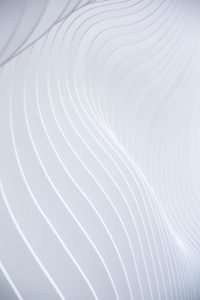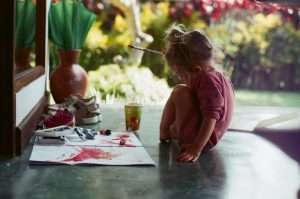Hello, hello! Welcome to the very first post of “How To Create A Cute And Colorful Character!” This is going to be a long series of blog posts, starting today with what I consider the most important aspect of character design: proportions.
Here’s an example of a character sheet I drew at work today.
It’s not the prettiest thing ever, but it demonstrates the very basic principles of proportioning a character.
Proportion-wise, she’s a little taller than average and has slightly thinner limbs than average. Her head is somewhat larger than her body, though not as large as some characters are. Her eyes are big and expressive and her mouth is small and flat (because she’s wearing lipstick). Her hair is short and spiky and cute. Her clothing shows that she’s fashionable but not overly so (the scarf).
Her proportions are exaggerated in the way that all cartoon characters are, but they’re still pretty realistic from the standpoint of someone who knows how bodies actually work. She isn’t anatomically correct or anything like that, but unless you’re a professional artist or trainer it’s unlikely that you’ll really know how to make an anatomically correct character anyway. So there’s no need to worry about exactness,
Cute characters can be hard to design. The eyes, the mouth, the hairstyle, the clothes and a lot more has to be considered in order to create a good character.
Tutorials in this blog will show you how to do it step by step and with a lot of practice!
This blog is open for all people who want to share their tips and tutorials about cute character design.
Cute characters are a staple of visual media. From Hello Kitty to Disney Princesses, it’s obvious that cute = popular. But what is it about cute characters that makes them so successful?
There are several elements involved in creating a cute character design. Many of these techniques can be mixed and matched to create your own unique look!
1. Big eyes.
2. Large head relative to body.
3. Roundness in general: round eyes, round body, circular clothing, etc…
4. A gap between the upper and lower lip.
5. A mouth turned down at the corners.
6. Hair is often styled with pigtails or bows, but also curls are very common (especially on girls).
7. Bright colors: pinks and purples are used for girls, blues for boys, and green for everyone else (as well as pastels).
8. Cuteness can be added to a non-cute character through accessories such as a stuffed animal or heart-shaped hair clip (or something similar).**
I’ve been getting a lot of questions on how to draw cute characters and I decided it was time to start a blog on this topic. Before we begin, you should know that there are no hard & fast rules on what cute is. In fact, within the Japanese culture, there are different ideas of what is “cute” depending on the individual.
However, I’m going to give you some tips that I’ve learned from working with my clients and other artists in order to help get your cute character designs off the ground.
Here’s what we’ll cover:
Cute characters are a common type of design in games, cartoons, and other forms of media. Creating a cute character from scratch can be very difficult and time consuming, but the payoff is immense.
Cute characters stand out from their more mature counterparts by having rounder faces without sharper angles, smaller eyes and mouths, and larger heads and hands. Cute characters have an appeal that goes beyond simple cuteness; they are often associated with innocence and youthfulness, which makes them appealing to a wide variety of people.
How do you go about creating a cute character for your game or cartoon? The first step is understanding what makes a character cute.
The second step is to build on that knowledge by sensibly adding elements to your character’s design. The key to creating a character that is both cute and appealing is not simply slapping on some big eyes and calling it a day. You must take the time to consider what elements you want in your character’s design and then skillfully add them one at a time while keeping an eye on how they affect the overall look of the character.
Cute art is a little bit hard, but with practice you will learn to do it. Cute art is a little bit hard, but with practice you will learn to do it. Cute art is a little bit hard, but with practice you will learn to do it. Cute art is a little bit hard, but with practice you will learn to do it.
Tutorials written by paula
The term cute is often used to describe something that appears youthful and endearing. There are various characteristics associated with the effects of cuteness. Cute imagery is used widely in advertising, on greeting cards and in many other forms of media. The characters created can be simple or complex, abstract or very detailed. It’s all about how you want it to look like.
Toon artists are not just drawing cartoons anymore; they are developing their own unique style of artwork. Some cartoonists create their own unique character while others use a famous character from a cartoon or TV show as their model. Whatever your background, you can learn to draw a cartoon character using one or more of these tutorials. When creating a cartoon character, you need to think about the basic shapes and body parts before putting them together into a whole. It’s best to start with an oval-shaped head and then add facial features such as eyes, nose and mouth, and glasses if needed. Follow these tips when creating a cute cartoon character!


